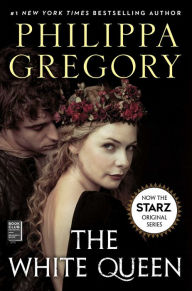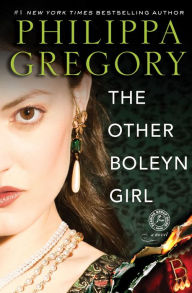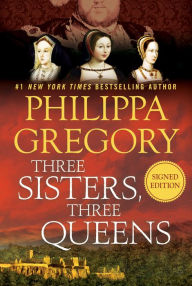Real History That Makes Game of Thrones Look Like Child’s Play
History is too often presented as a tale of individuals who momentarily rise above the tumult to make an indelible impression. In this flawed way of looking at the past, a figure like King Henry VIII is almost impossible to see beyond; his immense, authoritative figure shines like a sun in the 16th century, obscuring everyone around him. Add to that the casual chauvinism that pervades most of history, and it’s sometimes a surprise to people to learn Henry VIII had sisters, much less that they also had a huge impact on their time.
The White Queen
The White Queen
Paperback $18.00
The desire to highlight the truly amazing stories of women throughout history is what fuels the brilliance of author Philippa Gregory, who has become a genre unto herself with richly written historical fiction like The Cousin’s War series (adapted into the TV series The White Queen) and The Other Boleyn Girl. Gregory has turned her attention to the endlessly fascinating Tudor family in her latest work, Three Sisters, Three Queens, which not only explores the often obscured stories of Margaret Tudor, Katherine of Aragon, and Mary Tudor, but also their relationship as sisters.
The desire to highlight the truly amazing stories of women throughout history is what fuels the brilliance of author Philippa Gregory, who has become a genre unto herself with richly written historical fiction like The Cousin’s War series (adapted into the TV series The White Queen) and The Other Boleyn Girl. Gregory has turned her attention to the endlessly fascinating Tudor family in her latest work, Three Sisters, Three Queens, which not only explores the often obscured stories of Margaret Tudor, Katherine of Aragon, and Mary Tudor, but also their relationship as sisters.
The Other Boleyn Girl
The Other Boleyn Girl
Paperback
$5.98
$16.99
A Woman’s Voice
Three Sisters, Three Queens is told entirely from the point of view of Margaret, the eldest daughter of King Henry VII. Henry has just cemented his hold on the throne after the disastrous Wars of the Roses, and the defeated Plantagenets continue to lurk and plot, risking the Tudor grip on power. Margaret and her younger sister Mary are not just princesses but also essential diplomatic tools, to be married off in order to forge alliances. By telling this story through Margaret’s perspective, Gregory rejects the idea that a woman in her position would have simply sat around waiting to be told who she was to be married to, portraying her instead as a dynamic figure keenly aware of her role, her importance, and her limitations. The fact that Margaret Tudor sneers at her younger brother Harry—the future King Henry VIII—as a spoiled, silly boy, is a clear indication this will be a story told from a fascinating and subversive alternative viewpoint.
A Woman’s Voice
Three Sisters, Three Queens is told entirely from the point of view of Margaret, the eldest daughter of King Henry VII. Henry has just cemented his hold on the throne after the disastrous Wars of the Roses, and the defeated Plantagenets continue to lurk and plot, risking the Tudor grip on power. Margaret and her younger sister Mary are not just princesses but also essential diplomatic tools, to be married off in order to forge alliances. By telling this story through Margaret’s perspective, Gregory rejects the idea that a woman in her position would have simply sat around waiting to be told who she was to be married to, portraying her instead as a dynamic figure keenly aware of her role, her importance, and her limitations. The fact that Margaret Tudor sneers at her younger brother Harry—the future King Henry VIII—as a spoiled, silly boy, is a clear indication this will be a story told from a fascinating and subversive alternative viewpoint.
Three Sisters, Three Queens (Signed Book)
Three Sisters, Three Queens (Signed Book)
Hardcover $27.99
Status as Power
Despite their lack of discernible power and influence, the women in Three Sisters, Three Queens manage to establish themselves as the Invisible Hand of the Tudor dynasty. In particular Margaret’s grandmother, Margaret Beaufort (the daughter of John of Gaunt), is depicted as a formidable force in England, a woman who exerts considerable influence and whom no one, not even the king, crosses with equanimity. And while it’s clear that Margaret and her sisters—young Mary and her sister-in-law twice over, the Spanish princess Katherine of Aragon—are used as pawns and directed to marry as their male relations require, Margaret’s response to these pressures makes it clear this doesn’t mean they are without control over their fates. It may be limited by the laws and attitudes of the time, but each sister exerts the power she can (including her status, her ability to inspire awe, and, ultimately, her children) in ways that are both clever and terrible.
Sisterhood
In the Tudor world Gregory depicts, the relationship between these three women, each destined to become queens, is of as much significance as the machinations of the men who wear the crowns and control the armies. Margaret herself ascends to the throne as the Queen of Scotland when she is just twelve years old; her sister Mary eventually becomes Queen of France; and Katherine of Aragon marries Margaret’s silly younger brother Henry, becoming Queen of England. Of course, with great power comes great responsibility—and often great tragedy. War between France and England pits Margaret against her brother Henry VIII. Katherine cannot give Henry a male heir, and sees her position erode steadily until her desperate husband has their 24-year marriage annulled in order to marry Anne Boleyn. Mary, married to the much older King of France, willingly accepts an uncertain future when she marries for love after the king’s death, angering her brother. Gregory views history not through the traditional lens of powerful men exerting their wills, but through the lens of this sorority of women who don’t always like each other, but who share common frustrations and common goals.
As with all of Gregory’s work, the really brilliant part of this novel is the fact that despite knowing how it ends—after all, it is history—Gregory keeps the reader spellbound. With hints of a secret history, a dash of unexpected (and historically unrecorded) motivation, and her usual nimble wordplay, Gregory creates a world that feels fresh and exciting despite having been studied and analyzed for centuries. The fact that she can achieve this in part simply by focusing on women instead of men shows how much of history really remains unexamined.
Status as Power
Despite their lack of discernible power and influence, the women in Three Sisters, Three Queens manage to establish themselves as the Invisible Hand of the Tudor dynasty. In particular Margaret’s grandmother, Margaret Beaufort (the daughter of John of Gaunt), is depicted as a formidable force in England, a woman who exerts considerable influence and whom no one, not even the king, crosses with equanimity. And while it’s clear that Margaret and her sisters—young Mary and her sister-in-law twice over, the Spanish princess Katherine of Aragon—are used as pawns and directed to marry as their male relations require, Margaret’s response to these pressures makes it clear this doesn’t mean they are without control over their fates. It may be limited by the laws and attitudes of the time, but each sister exerts the power she can (including her status, her ability to inspire awe, and, ultimately, her children) in ways that are both clever and terrible.
Sisterhood
In the Tudor world Gregory depicts, the relationship between these three women, each destined to become queens, is of as much significance as the machinations of the men who wear the crowns and control the armies. Margaret herself ascends to the throne as the Queen of Scotland when she is just twelve years old; her sister Mary eventually becomes Queen of France; and Katherine of Aragon marries Margaret’s silly younger brother Henry, becoming Queen of England. Of course, with great power comes great responsibility—and often great tragedy. War between France and England pits Margaret against her brother Henry VIII. Katherine cannot give Henry a male heir, and sees her position erode steadily until her desperate husband has their 24-year marriage annulled in order to marry Anne Boleyn. Mary, married to the much older King of France, willingly accepts an uncertain future when she marries for love after the king’s death, angering her brother. Gregory views history not through the traditional lens of powerful men exerting their wills, but through the lens of this sorority of women who don’t always like each other, but who share common frustrations and common goals.
As with all of Gregory’s work, the really brilliant part of this novel is the fact that despite knowing how it ends—after all, it is history—Gregory keeps the reader spellbound. With hints of a secret history, a dash of unexpected (and historically unrecorded) motivation, and her usual nimble wordplay, Gregory creates a world that feels fresh and exciting despite having been studied and analyzed for centuries. The fact that she can achieve this in part simply by focusing on women instead of men shows how much of history really remains unexamined.


